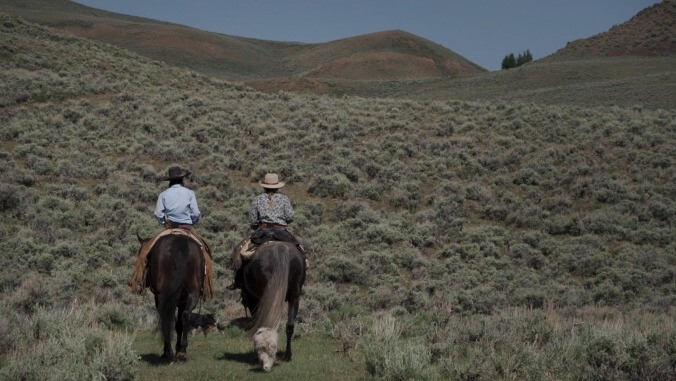In Bitterbrush, these cowgirls are too busy to get the blues
Emelie Mahdavian's elegant documentary offers an understated but much needed corrective to traditional Western iconography
Film Reviews Bitterbrush
The documentary Bitterbrush follows an entire season of cattle herding in the austere, snow-dusted Idaho mountains. It’s a deeply immersive experience, analogous to learning a language using the Michel Thomas Method. With Thomas, you follow along with two students in the recordings as if you were the third. Similarly, Bitterbrush director Emelie Mahdavian allows you to tag along with two range riders, listen in on intimate conversations, and bask in spectacular and sometimes unforgiving nature as you observe their way of life.
Colie Moline and Hollyn Patterson are seasonal workers who peregrinate to different ranches to help round up cattle–about 1,000 head as stipulated in this particular contract. It’s like Nomadland, but demands much higher skill and competence levels. They get excited about their cabin—despite it not having a functional toilet—after a couple of years of living out of a camper. They spread tuna from single-serving packets onto sliced bread flattened during the ride, and wash it down with Pepsi. They warm up corned beef hash in the can on the gas stove. They mend barb wire fences. With the assistance of about a dozen dogs, they herd cows through vast plains, up mountains, into woods, and across highways. After an arduous day, they nurse the doggies’ sore paws. There’s no romanticizing; this is life.
Bitterbrush dispels a few enduring myths and stereotypes about the American West that media have perpetuated for ages. Indeed, this is neither Sam Elliott’s vision nor Jane Campion’s. Yes, this existence requires resilience, solitude, and other qualities we deem virtuous. Though Moline and Patterson wear the hats, vests, and boots with rowel spurs, they track anniversaries on Facebook, order blankets on Amazon, and keep up with the Kardashians. Moline apparently comes from a family of ranchers; her father wants her to go home but has given full rein of the family biz to her brother. Had there been equal representation of women range riders like Moline in popular culture, would she be afforded equity at home? It’s something worth pondering, which is what makes Bitterbrush edifying.
So many girls are into horses that the phenomenon warranted an All Things Considered segment in 2011. The fascination with the equine is unfathomable to anyone who has ever caught a waft of manure while jogging in Central Park. Practicalities are also never part of that fantasy. One scene shows the skills and patience required to break a horse: Marilyn the mare is wary of humans, and takes several steps back every time Patterson approaches. After getting nowhere alternating between good cop and bad cop tactics, she finally enlists the help of her husband, Elijah. She isn’t the only one who can use a hand; in another scene, he requires her assistance to give a stubborn cow an injection.
The Idahoan peaks provide a breathtaking backdrop as expected, but what makes Derek Howard and Alejandro Mejía’s cinematography stand out is how they capture intimacy against these immense surroundings. The camera glides smoothly, unobtrusively trailing the range riders, simulating the experience of riding along. Curtiss Clayton, who edited many of Gus Van Sant’s films, lends this doc a dexterity usually reserved for fictional films. The sleight of hand helps imbue the narrative with poetic resonance. And the caliber of storytelling is so transcendent that the documentary feels like cinéma verité.
One complaint is that the sound is quite muddled, and sometimes the viewer must strain to make out what the cowgirls are saying to each other. The score, Greg Anderson and Elizabeth Joy Roe performing J. S. Bach, at times drowns out the conversations. It can be frustrating, because the words are audible enough to assume Mahdavian has kept the banter within earshot on purpose. The score helps set the mood, but it’s superfluous. The film can do without it.
Nevertheless, Mahdavian’s travelogue-character study feels like a cooling balm for those who can’t afford to take time off and travel this summer. It’s a road movie about life-affirming friendship and sisterhood, a meditative and healing journey through the American West. Even more than you wanted Frances McDormand and David Strathairn to solidify something at the end of Nomadland, you genuinely wish for good things to happen to the amazing people of Bitterbrush that you meet along their way.
1 Comment
Let’s just take a moment to appreciate the name “Marilyn the mare”.